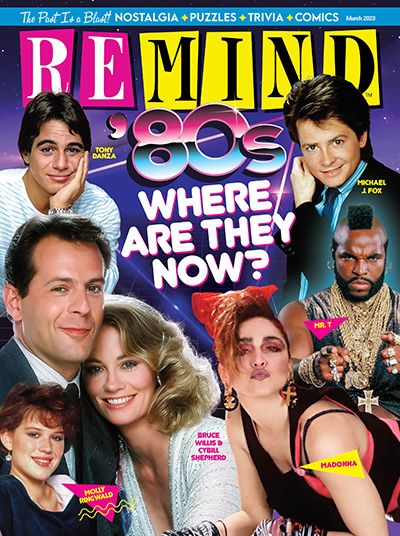Billy Squier Quit the Music Industry, But His Hits Haven’t Stopped

If you want to talk about ’80s arena rock, you have to talk about Billy Squier. The singer-songwriter’s bouncy, infectious anthems were an inescapable part of the first half of that decade, and a staple of the early years of MTV. But just as quickly as Squier burst on to the scene, he seemed to disappear, formally pulling the plug on his mainstream music career in 1993, and performing live only sporadically thereafter. How did his career go from multi-platinum to non-existent in less than a decade? The answer involves new trends, a changing music industry, and, depending on who you believe, one very cheesy music video.
Originally hailing from the Boston suburb of Wellesley, Massachusetts, Squier spent the ’70s in New York City, playing with the rock band Piper. Though the band was critically well-reviewed and even toured with Kiss, they failed to get any traction with listeners. Squier released his first solo album in 1980, The Tale of the Tape, but while the single “The Big Beat” got some radio airplay, the album didn’t make a big splash.
All of that changed with 1981’s Don’t Say No, a monster album which spawned four hits, spent over two years on the Billboard charts, and eventually went triple platinum. Squier’s videos, especially the live performance video for “The Stroke,” became staples on the then-new MTV, and soon, he was playing his arena rock in actual arenas. He quickly followed up with 1981’s double platinum Emotions in Motion, with cover art by Andy Warhol. The album hit the top five, and yielded Squier’s first #1 Billboard rock hit, “Everybody Wants You.”
Squier worked with Meatloaf collaborator Jim Steinman for 1984’s Signs of Life, which saw the singer embracing a poppier sound. The album was also a hit, with the single “Rock Me Tonite” reaching #1 on the rock chart, but it didn’t sell as well as his previous two. “I didn’t have the support from my management” or label, Squier observed at the time.
Soon after, Squier’s career seemed to precipitously drop off. His 1986 album, Enough Is Enough, saw a significant dip in sales, as did his next, 1989’s Hear & Now. 1993’s To Tell the Truth was his last major label album with Capitol Records; it sold only 37,000 copies. Squier then officially “walked away” from the music business.
Why did Billy Squier disappear?
One explanation is that times simply changed. The 1992 charts were dominated by country artists like Billy Ray Cyrus and grunge rockers Pearl Jam and Nirvana; Squire’s sounds were out of fashion. In 1993, Squier’s label got a new president, and because of that, according to Squier, “this [album] was dead in the water from the start.” Feeling that Squier’s sounds were unfashionable, Capitol didn’t give the album any promotional support. A frustrated Squier decided to put his music career in the rearview mirror. Though he self-produced a stripped down acoustic album, Happy Blue, in 1998, it was more a blip than a comeback, and Squier continued to step back from the music industry.
But according to another explanation, Squier’s downfall began in 1986, when his career was at its peak. Billy Squier was one of the most prominent performers on MTV, so Signs of Life‘s first single, “Rock Me Tonite,” required a great video. However, according to Squier, his preferred video directors weren’t available, and MTV didn’t want to move the premiere date they had committed to. Running low on options, Squier decided to work with director Kenny Ortega. Ortega, who went on to direct Hocus Pocus and the High School Musical films, was already an acclaimed choreographer — after a long run designing stage shows for the Tubes, he c0-choreographed Xanadu and Madonna‘s “Material Girl” video. The clip Ortega shot for Squier was supposed to be inspired by American Gigolo.
But the video, which featured Squier writhing around on satin sheets and dancing awkwardly around an apartment in a pink tank top, seemed to challenge his previous image as a virile, macho rock star. Joe Elliott of Def Leppard recalled, “We were watching it through our fingers. I remember saying at the time, ‘Mick Jagger can get away with that … Billy Squier can’t.'” Squier claimed the video wasn’t what he had agreed to, and it had an immediate impact on his career. Shortly after its release, he said, “I was playing to half-houses. I went from 15,000 and 20,000 people a night to 10,000 people. Everything I’d worked for my whole life was crumbling, and I couldn’t stop it. How can a four-minute video do that?” Though he released multiple albums after that, his career seemed to be yielding diminishing returns, until eventually sputtering out.
>>Whatever Happened to Journey’s Original Singer Steve Perry?
Where is Billy Squier now?

Al Pereira/Getty Images
So with his guitar gathering dust, what did Squier do with himself? He wrote a screenplay in 1994 that was honored at the Sundance Film Festival, and since 2000, he has been a very active volunteer for the Central Park Conservancy, a group which maintains plant life in New York City’s Central Park. “I much prefer the company of nature to the poison of the business community,” he said.
In 2006 and again in 2008, Squier played with Ringo Starr & His All-Starr Band, alongside Edgar Winter, Sheila E., Richard Marx, Dr. Hook, and Ronnie Spector, among others. “I thought, ‘Yeah, why not? It could be fun.’ You know, they take care of you, you play with some great musicians, you play with a Beatle – how bad can it be?” Squier said in a 2023 interview on “The Eddie Trunk Podcast.” “It was great – I had a great time. I did a couple of years with him and that sorta got me going again.”
Squier still plays the odd live gig, and in 2023, he released his first new song since 1998: “Harder on a Woman.” But he’s generally eschewed the reunion tour circuit. Some of that might be due to his distaste for the music industry, but it might also be because he doesn’t need the cash — he’s one of the most-sampled artists in musical history. Remember “The Big Beat,” Squier’s 1980 song that never quite charted? It’s been sampled over 200 times, including in Jay-Z‘s “99 Problems” and Alicia Keys’ “Girl on Fire.” “That has been totally unexpected — and mind-blowing,” Squier said in 2006. “It has taken on its own cult of personality, and I’m kind of like the Robert Johnson of hip-hop! It’s very cool.”
View this post on Instagram

’80s Where Are They Now
March 2023
Who can forget all the great TV shows, movies and music of the ‘80s? See what your favs are up to now!
Buy This Issue